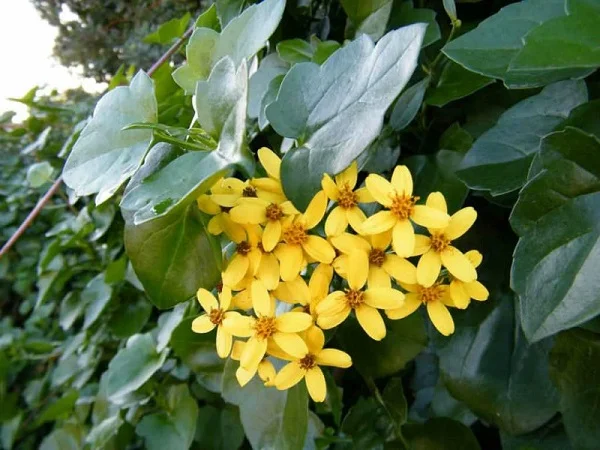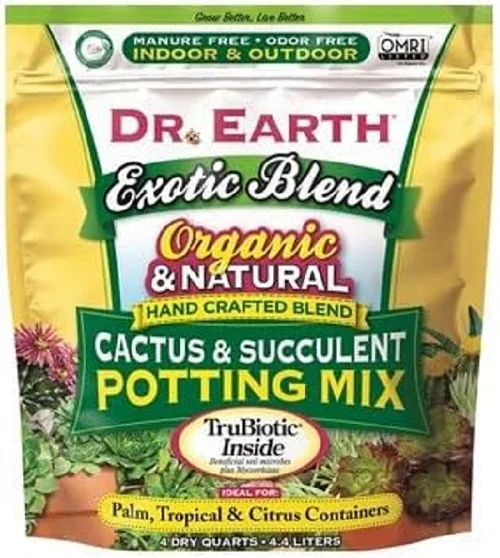Scrambling Groundsel (Senecio angulatus) Indoor Care and Propagation Guide
Some links in this post may be affiliate links
Scrambling Groundsel (Senecio angulatus) prefers medium to bright indirect light, average warmth, moderate humidity and moderately moist, rich, well-drained, succulents soil coupled with monthly feeding in the growing season.
Senecio angulatus also called Climbing Groundsel, Creeping Groundsel or Algerian Senecio is one of the scrambling and twining, shrubby Senecio varieties whose leaf lobes are fleshy, glossy, green, pointed, coarsely-toothed with 3-5 teeth on each side. The leaves are alternately arranged and about 8 inches long by 5.5 inches wide.
Scrambling Groundsel is similar to Senecio mikaniodes (German Ivy) but the leaves in German Ivy have several pointed lobes.
The veining stems in Climbing Groundsel can either trail in a hanging basket or be trained up a cane or a trellis. It is one of the best succulents for hanging baskets.
To control Creeping Groundsel's growth when grown indoors, regularly pinch the growing tips to encourage bushyness and also promote flowering.

Botanical name: Senecio angulatus
Synonmy: Senecio macropodus
Family: Asteraceae
Common names: Creeping Groundsel, Climbing Groundsel, Scrambling Groundsel, Algerian senecio
Origin
Senecio angulatus is native to South Africa where it grows as a vine that climbs up trees and can reach a height of 6.6 feet in the wild.
Flower
Scrambling Groundsel produces clusters of bright yellow, daisy-like, sweet-scented flowers borne at the end of the stems.
Invasiveness
According to Greater Wellington Pest and Weed Central, Scrambling Groundsel has been found to be invasive. It is not recommended to be planted in the ground as given time, it will smoother trees. To counter this invasive nature, always destroy the underground rhizomes before discarding as they easily resprout.
Toxicity
Senecio angulatus is toxic to both humans and pets according to The American Society for the Prevention of Cruelty to Animals. If ingested, it can cause vomiting, diarrhea and abdominal pains. Keep the plant away from the reach of children and pets.
Senecio angulatus Care Indoors
Scrambling Groundsel (Senecio angulatus) grows best in medium to bright indirect light, average warmth of 18-280C, humidity of 50-55% and moderately moist, rich, well-drained, succulents potting soil coupled with monthly feeding during the growing season.
Senecio angulatus requires pruning to keep the plant neat, to minimize pest and disease infestation and promote a bushy growth. Repotting is only needed when the plant becomes pot-bound. Keep reading for more on these growing conditions and how to achieve them.

Light Requirements
Scrambling Groundsel grows best in medium to bright indirect light conditions. Keep it away from direct sunlight as it can cause scorching of the leaves.
It can also grow under a grow light where the natural lighting is inadequate. Check out these full spectrum grow lights on Amazon.
Regularly turn the pot to ensure that the plant receives light on all sides for uniform growth as well as prevent leggy growth.
Watering
Water Scrambling Groundsel thoroughly during the growing season and allow the top 2-3 inches of soil to dry out between waterings to keep the soil moderately moist.
Decrease watering during the cold period as growth is minimal at this time but do not allow the soil to dry out completely.
Ascertain that the pot has a draiange hole to prevent the soil from getting soggy as it can result in root-rot and death of the plant.
Temperature and Humidity
Scrambling Groundsel prefers average warmth of 18-280C. A room temperature that is comfortable for you is ideal for the plant. Keep it away from drafts to prevent sudden changes in temperatures as they can cause reduced growth.
Creeping Groundsel has no need for extra humidity. Average room humidity of 50-55% is adequate for this plant. Occasionally clean the leaves under a stream of running water to get rid of dust and discourage pest infestation. Ensure proper ventillation to minimize fungal diseases.
Fertilizer
Feed Scrambling Groundsel monthly during the growing season with a balanced, liquid fertilizer for lush growth. Do not feed in the cold season as growth is minimal and feeding at this time can cause fertilizer burn.
Potting Mix
The best soil for Scrambling Groundsel should be rich in organic matter, loose and free-draining to avoid getting soggy soil. The soil should be loose enough to allow water to drain out fast enough. Cactus and succulents mix is ideal as it drains easily.
Repotting
Repot Creeping Groundsel every 2-3 years during the growing period. Use a pot which is 1 size larger than the current one. Ensure the pot has a drainage hole to avoid getting soggy soil as it can lead to root-rot. Take a look at these pots with drainage holes on Amazon.
Pruning
Pruning Scrambling Groundsel involves removal of yellow and dead leaves to maintain the plant neat and also discourage pest and disease infestations. To encourage a bushy and compact growth, pinch off the growing tips. You may choose to use the tips propagate new plants. Cutback leggy stems at the beginning of the growing season to rejuvenate growth.
Propagation
Scrambling Groundsel (Senecio angulatus) is propagated at the beginning of the growing season from the stems. They root easily so there is no need for rooting hormone. The stems can be rooted in 3 ways. Keep reading for more on these rooting methods.
1. How to propagate Scrambling Groundsel stem-tip cuttings in soil
Take stem-tip cuttings of about 4-5 inches from a healthy Scrambling Groundsel. Ensure that each cutting has 2-3 leaf nodes as this is where new growth will come from.
Fill your rooting container with well-drained, rooting mix. Moisten the soil lightly.
With a pencil or similar object make a hole in the moist rooting mix.
Insert the cutting in the previously made hole. Light cover the base of the cutting with the rooting mix.
Place the set up in warm, well-lit place away from direct sunlight and maintain the soil moist until new growth emerges and substantial growth has been observed.
Transfer the new Senecio angulatus to individual pots and begin routine care. For a fuller plant, transfer several cuttings into one pot.
2. How to propagate Scrambling Groundsel stem-tip cuttings in water
Take cuttings of about 4-5 inches from a healthy Scrambling Groundsel. Ensure each cutting has 2-3 leaf nodes as this is where new growth will come from.
Place the cuttings in a jar of plain water. Place in a warm, well-lit spot away from direct sunlight. Change the water every 5-7 days.
When a good amount of roots have formed on the cuttings, transfer the cuttings into moist potting soil.
Position the set up in a warm, well-lit place and maintain the soil moist until new growth has emerged and substantial growth has been observed.
Transfer the new Senecio angulatus to individual pots and begin routine care. Several cuttings can be planted in one pot for a fuller plant.
3. How to propagate Scrambling Groundsel by spreading the stems on the soil
Spread the Scrambling Groundsel stems on the soil surface while still attached to the mother plant. Press the stems lightly so that they touch the soil.
After some time, the stems will root at every point that they are into contact with the soil.
Once rooted, sever the stems from the mother plant. Dig them up and pot in moist soil in individual pots.
Place the new Senecio angulatus in a warm, well-lit place and maintain the soil moist until they are well established.

Senecio angulatus Problems
Scrambling Groundsel (Senecio angulatus) growing problems iclude drooping leaves, curled leaves, leggy growth, pests and diseases . Read on for the solutions and remedies to these problems.
Pests
Common pests in Scrambling Groundsel are mealy bugs and aphids. Isolate the affected plant to prevent spread to other plants and treat it with insecticidal soap to get rid of the pests. Ensure to follow the manufacturer's recommendations
Diseases
Common diseases in Scrambling Groundsel are leaf spot disease and root-rot which is prevalent in too wet conditions. Isolate the affected plant to prevent spread to other plants and treat it for the diseases.
To discourage disease infestations, ensure that there is good air circulation at all times. In addition, make sure that the soil is free-draining and the pot has a drainage hole to prevent soggy soil.
Leggy growth and undersized (small) leaves
Leggy growth and undersized leaves in Scrambling Groundsel are caused by too little light. Move the plant to a brighter spot where it will receive medium to bright indirect light or instal a grow light if the natural lighting is not sufficient. Check out this guide on understanding light for houseplants.
Brown leaves with curled edges
Brown leaves and curled edges in Scrambling Groundsel are caused by overwatering or too wet soil (soggy soil). Ensure the soil is free-draining and the pot has a drainage hole. Water the plant only when the top 2 inches of soil have dried out and reduce watering during the cold season to avoid ovewatering. Learn more on how to water houseplants the right way.
Drooping leaves
Drooping leaves in Scrambling Groundsel are due to underwatering resulting in too little moisture in the soil. This means that the leaves loss more water to the air than they are getting from the soil which causes them to lose their turgidity (stiffness) and thus they droop.
Water the plant immediately it starts drooping and it should perk up. Do not allow the soil to dry out completely but only slightly before watering again.
You liked it? Share on social media.
Related Content
Amazon Associates Disclosure
Homeplantsguide.com is a participant in the Amazon Services LLC Associates Program, an affiliate advertising program designed to provide a means for sites to earn advertising fees by advertising and linking to amazon.com.





